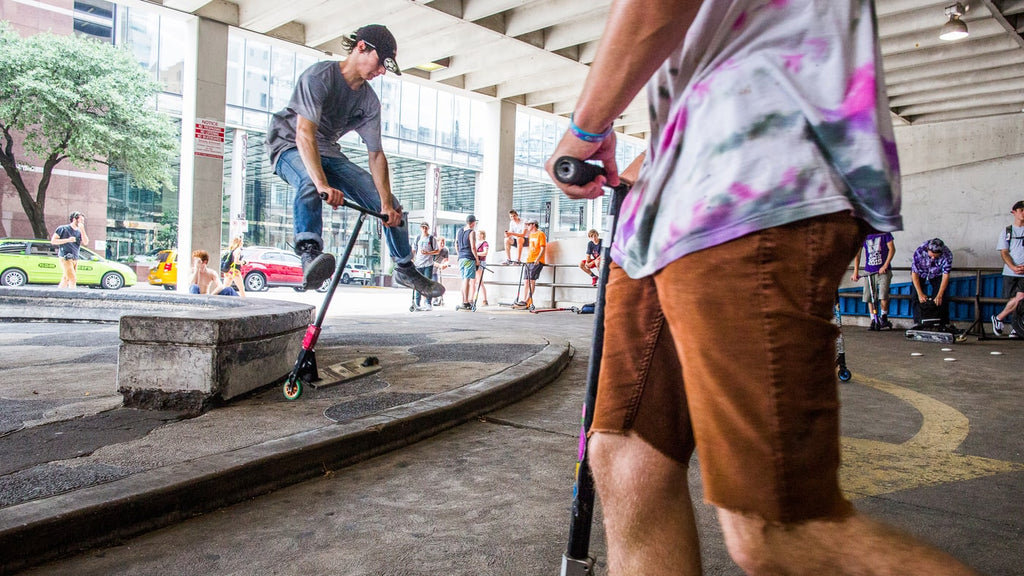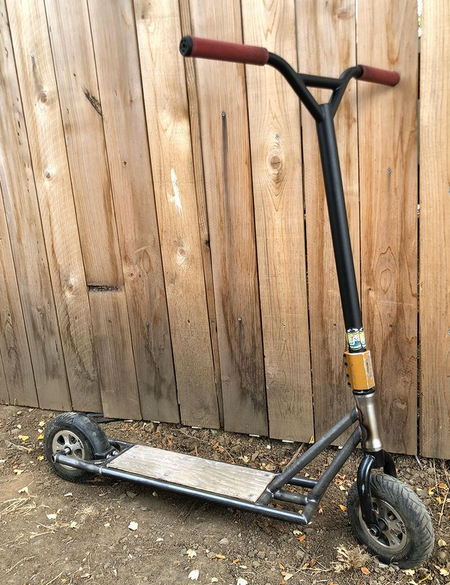It's called a street jam, where riders flock from all over the world to shred a city, performing tricks and causing the same type of mayhem more usually associated with skateboarders. For those who grew up during the Razor-scooter boom in the early aughts, it's hard to see a scooter as much more than a fad, let alone a symbol of rebellion, but that stereotype doesn't exist for the younger generation. Eighteen years after the release of the first Razor, scooters have come of age, spawning a uniquely millennial subculture with the same disruptive spirit as skateboarding – minus the steep learning curve. And according to many scooter riders, it's actually overtaking skateboarding in popularity.
"I've seen less and less skateboarders over the years," says Devin Szydlowski, a 17-year-old semi-pro rider who traveled from San Luis Obispo, California, to take part in the Chicago Jam in August, one of the largest in the U.S. "It depends on the [skate] park, but we have the majority. There's more scooter riders than skateboarders. We're targeting younger kids, whereas skateboarding is targeting older kids." A study on Statista.com by the Outdoor Foundation backs up his observation: The number of skateboarders in the U.S. decreased from 10.1 million to 6.4 million between 2006 and 2016, with an even more dramatic drop among skaters age six to 17.
"It's huge in other countries," says Logan Fuller, a 25-year-old whose baggy, torn jeans and mischievous eyes look straight out of a Nineties issue of Thrasher magazine. He's one of the best known scooter riders at the jam and is capable of grinding down a 22-stair handrail. Fuller is based in Maryland but basically lives on the road, traveling from jam to jam, supported by sponsorships and contest winnings. "I just went to Russia and France for street jams, they're crazy. There's, like, a thousand people," he says.
Starting at Grant Park Skate Park, the riders at the Chicago Jam – most of whom look under 18 – critical-mass through downtown, stopping along the way to grind down rails and spin scooters around their heads like helicopters. As with skateboarding, the chance of landing a trick is relatively low and the probability of racking yourself on a rail dangerously high.
The event is totally rogue, with no permits and no Internet trail outside social media. Historically, it was organized by a prominent scooter manufacturer, but this year it grew too large for a business to carry the legal liability should (or when) the cops arrive. It's so loosely planned that there's not even a route map; organizers simply direct the mob using a megaphone.
The best tricks win prize money, crucial since many of the top street scooter riders backpack across the country for months at a time. But what's more important than money is the opportunity to put faces to Instagram names. After the jam, kids gather in a warehouse to watch the premiere of a scooter film, buy scooter art prints and mosh to a performance by Atlanta rapper KZ, whose Instagram features as many photos of him on a scooter as in the studio. There's a rebellious spirit to the gathering, and half the young riders seem like the type to sneak cigarettes between classes – but good luck asking any of them for a lighter. After all, this is the vaping generation.
Skateboarding's roots lie in 1960s surf culture, but push scooters originated as much more of a kids' toy. The image started to change when Razor launched its insanely popular "Pro" model in 2000. The founder owned a toy company and saw that scooters had become trendy as transportation for Japanese businessmen in Tokyo, thus the brand's initial retail partner: The Sharper Image (sticker price: $149). They sold at a pace of one million units per month for the first six months.
Razor soon realized that scooters could become a new action sport and began to invest in building a community. In 2001, they offered a $1,000 prize for the first person to land a backflip and created the first touring team of riders.
"We started putting on competitions locally and then a national tour," says Ali Kermani, a skateboarder who helped Razor cultivate its extreme-sports program. "We'd go all over the place to skate parks that had strong scooter scenes, like the Incline Club in New Jersey and Skate Barn West in Washington [State]. Then the first street jams started happening in New York."
Even though the sport isn't recognized by the X-Games and no Tony Hawk figure has propelled it to the mainstream, athletes are innovating at an unprecedented pace. The most groundbreaking trick in skateboarding history is likely Hawk's 900 at the 1999 X-Games, the result of nearly 50 years of skating progression. Scooter rider KC Corning landed one in 2004, showing how quickly the sport is evolving.
"Scootering is the first sport that developed through the Internet, so we were able to build a whole industry in just a few years," says Andrew Broussard, considered by many to be the godfather of scootering. He landed his first tailwhip on July 4th, 2001, and became hooked. While still in high school, he launched Scooter Resource, a message board that for the next decade would be the website of record for the community. Broussard also began hacking together custom scooters capable of taking more abuse, a business originally branded Scooter Resource in 2006, before being renamed Proto Scooters in 2008. The company doubled its revenue for six years straight, its growth only slowing once a rush of other companies entered the market.
A rift exists between "park" and "street" brands, with street riders preferring upstart, rider-owned companies like Proto and TSI to corporate operations like Fuzion (available at Walmart). Scooters are modular, which has created a marketplace for component-specific companies like River Wheel Co. and Tilt, which produces nearly indestructible wheels, decks, forks and even the clamps that connect the parts. Scooter riders (or often their parents) drop up to $700 on pro-level rides, a sharp contrast to the costs of earlier models.

The lexicon of tricks grew and was cataloged on Scooter Resource with specific credits for the pioneers behind each move. Because a scooter has handlebars like a BMX bike and a deck like a skateboard, it's a hybrid capable of incorporating tricks from each with a much quicker learning curve, which is undoubtedly part of why it appeals to a younger crowd.
"When you first start out skating, you can't just ollie right away, you have to practice for six months," says Szydlowski. "On a scooter, a bunny hop takes, like, a day to learn. Or an hour."
Today's riders mainly find inspiration on YouTube. It's resulted in underground scooter celebrities like the Funk Bros – Corey and Capron Funk – who are far from household names but boast 3.5 million subscribers. Scooters still play a part in their videos, but they're now known mainly as Jackass-style pranksters (who can land triple front flips). Ryan Williams, a well-known rider of both scooters and BMX bikes, has 950,000 Instagram followers. But despite these riders' huge followings, their popularity leaves little trace outside social media.
The rest of the community is the same; nearly everything happens on Instagram or Facebook. According to Tommy Daddono, one of the organizers of the Chicago Jam and a founder of scooter manufacturer Outset Select, his event is one of the most popular street jams in the world, but it was un-Googleable until a week after the dust had cleared.
Since pro-level scooters are so costly, many of the kids come from affluent backgrounds. Despite this, the scene feels decidedly DIY. Riders dress with a mix of grungy skater gear and a touch of Internet irony. One middle-school rider in Chicago wore a black cap with small text reading "Link in Bio." Just like skateboarders, shredded jeans and dirty Vans are the style, but unfortunately for the burgeoning scene, it takes more than just streetwear to convince skateboarders who came of age during Razor's initial boom that scooters are cool. Landing a backflip at a skatepark definitely turns heads, but a combination of entitlement and inexperience has made most scooter riders a bane to skateboarders, inline skaters and BMX riders.
"There's a stigma because of all the little kids," says Daddono. "Every skateboarder will tell you that [scooterers] don't look where they're going, they'll ride in front of you. They don't have the etiquette yet." Many simply never learn, which Broussard credits to a lack of guidance from older kids. "Skaters will complain about it, but they'll never go up to scooter riders and explain why what they're doing is dangerous or bad park etiquette," says Broussard. "But if it's a young skateboarder, they'll give them pointers and help them out. It's a hypocritical attitude."
Pioneering riders like Daddono, 24, and Broussard, 31, turned to scooting because they felt skateboarding's street credibility died with its commercial boom. Buying a board at the mall wasn't rebellious. Instead, early scooter riders dug through garage sales for dollar scooters, took them to skate parks and rode them until they were literally destroyed – typically about an hour.
"Skateboarding used to be anti-establishment, but now if you wear skate clothing, you're trendy," says Broussard. "Scooters started [out] punk-rock. The older generation couldn't afford skateboards or BMX bikes, but we could dumpster-dive for scooters."
"Every skatepark I've been in, there's always a skateboarder with a chip on their shoulder and are super mad," says Szydlowski. "Skateboarders are trying to make themselves feel better, because they know that their sport is dying in a sense."
Although events like the Chicago Jam appeal to a younger audience, it's the relatively older kids who play the starring roles. Mike Hohmann, a 22-year-old with frayed Kurt Vile hair, is a good bet to win prize money at any jam. He's based in Florida but has spent the past six months couchsurfing between events across the country. In May, he won several hundred dollars for grinding a 30-foot rail called the Green Monster in Austin and had a similar payday in Chicago for landing a backside 360 bar twist down a dozen steps at Grant Park. Once Hohmann's cash runs dry, he'll return to Florida to work a pair of minimum-wage jobs to save for his next trip.
"It's the community I love. It doesn't matter who you are, what you are, everyone's a brother here," says Hohmann.
Scant documentation of the community has emerged outside social media, but the scene does have historians. One is Dylan Kasson, a professional rider for Proto who has photographed scooting for a decade and hosts a popular podcast, Tandem. He's produced several photo books and is compiling a larger survey of the sport that he hopes to publish under the title The Scene.
"Scootering is so new that it's still in that stage where there's a lot of untapped potential," says Kasson. "Videos are the most important thing. That's how people realize new tricks are possible."
As documentation of the sport grows, so does the industry around it. As with skateboarding, apparel companies like Sky High have formed to serve the subculture. The 11th annual Scooter Con in San Diego boasted 1,500 attendees, and in October, Vault Scooters hosted the first-ever invitational competition, called Sovereign of Street, which had a prize pool of $11,000. Scooters are also a big part of Nitro Circus, an internationally touring stadium event with an emphasis on daredevil mega-ramps (it's where Capron Funk landed that triple front flip).
Even though it's still a fresh industry, it might already be getting too mainstream for Broussard, who fears the popularity could ruin the rebellious character, just like with skateboarding."The founding generation of scooter riders is drastically different than the current generation," he says. "We rode because after the Razor boom, it was not trendy. We were experimental. Now, some kids spend more time accessorizing their scooters than riding them."
Rebelliousness was certainly on display in Chicago, however. It's hard to call a mob of 300 kids riding into oncoming one-way traffic anything but daring. They were not only endangering their own bodies by running red lights and hurling themselves down stairs, but also destroying public and private property. The Most Disorderly Conduct Award went to a teenager who climbed to the top of a 20-foot wall overlooking a loading dock, then launched himself off it with a sinister grin, landing on the roof of a parked van and nearly causing the roof to cave in.
"Just like with every sport, there's the rebellious scootering, where it's just haywire, no one gives a crap and they just do illegal things," says Szydlowski.
Even so, not even the police seemed convinced this was a group to be concerned about. The only real legal altercation happened at a 10-foot ledge overlooking a busy street. Riders filed into the road to block off cars and, surprisingly, the first officer on the scene graciously looked the other way. He just seemed shocked that these kids would attempt something so stupid and asked that no one hurt themselves, a luxury that would've never been afforded to skateboarders. After about 10 minutes and a few very dangerous tricks, another cop arrived and quickly broke up the scene. The organizers thanked the officers over the megaphone and the scooter riders erupted in applause, but not before a mumbled chorus of younger voices could be overheard saying, "Fuck the police!"


